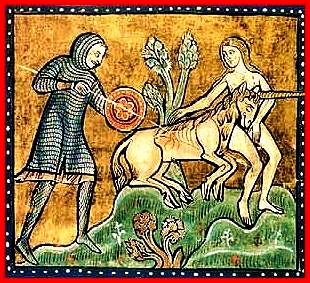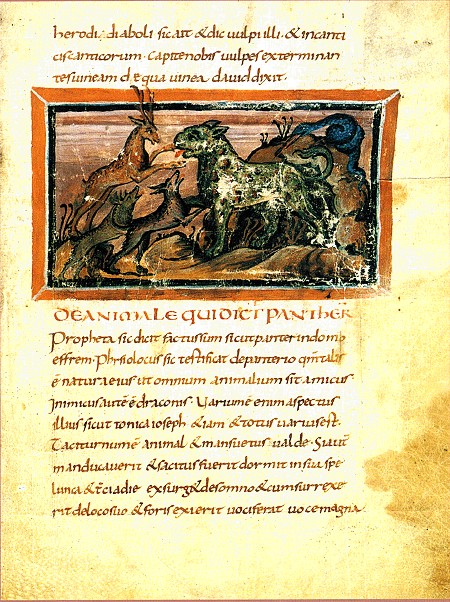Skip to comments.
Catholic Word of the Day, 02-27-09, PHYSIOLOGUS
CatholicReference.net ^
| 03-27-09
| Fr. John Hardon's Modern Catholic Dictionary
Posted on 03/27/2009 6:00:39 PM PDT by Salvation
Featured Term (selected at random):
PHYSIOLOGUS
A collection of Christian allegories in which religious truths are symbolized by animals. An outstanding example is the pelican who feeds its young by shedding its own blood, as Christ saved mankind by shedding his blood. They were very popular in the Middle Ages and greatly influenced ecclesiastical art and medieval literature.
All items in this dictionary are from Fr. John Hardon's Modern Catholic Dictionary, © Eternal Life. Used with permission.
TOPICS: Apologetics; Catholic; History; Theology
KEYWORDS: catholic; catholiclist
For these last two weeks of Lent I have begun posting a Catholic Word of the Day. Would you like to continue?
Is there anyone who would be willing to take on posting that?
1
posted on
03/27/2009 6:00:39 PM PDT
by
Salvation
To: nickcarraway; Lady In Blue; NYer; ELS; Pyro7480; livius; Catholicguy; RobbyS; markomalley; ...
I had never heard of this.
Do you want to continue with a Catholic Word of the Day after Lent?
2
posted on
03/27/2009 6:02:08 PM PDT
by
Salvation
( †With God all things are possible.†)
To: Salvation
3
posted on
03/27/2009 6:16:46 PM PDT
by
GOP_Lady
To: Salvation
No. But thanks for asking.
To: Salvation
I just wrote NO and then I see how interesting the word is so I recant. YES.
To: Salvation
To: Salvation
Actually, I knew about the pelican. There is a relief of one under the altar in the Blessed Sacrament Chapel at the Cathedral here. I happened to be there when a tour went through one time.
7
posted on
03/27/2009 9:49:18 PM PDT
by
Desdemona
(Tolerance of grave evil is NOT a Christian virtue. http://www.thekingsmen.us/)
To: Desdemona; lightman
So what other animal allegories are there.
I thought about the
whale
camel
gnat
dpgs
8
posted on
03/27/2009 9:53:50 PM PDT
by
Salvation
( †With God all things are possible.†)
To: Desdemona; lightman
So what other animal allegories are there.
I thought about the
whale
camel
gnat
dogs
9
posted on
03/27/2009 9:54:03 PM PDT
by
Salvation
( †With God all things are possible.†)
To: Salvation
10
posted on
03/28/2009 6:37:52 AM PDT
by
Bigg Red
(Palin in 2012!)
To: Bigg Red
I have a whole book on these kinds of stories. Do you want contributions of a word of the day or of these animal stories?
11
posted on
03/28/2009 6:46:03 AM PDT
by
DeLaine
(30 degrees and holding)
To: Bigg Red
12
posted on
03/28/2009 7:01:06 AM PDT
by
bboop
(obama, little o, not a Real God)
To: DeLaine
You can see that the topics are selected at random as they pop up on the website.
I’ll go from there during these two weeks.
Maybe later, if someone else wants to take it on.
13
posted on
03/28/2009 9:33:37 AM PDT
by
Salvation
( †With God all things are possible.†)
To: Salvation
I would enjoy it.
Thanks for all you do here. You’ve helped me a lot over time, as a lurker, and really appreciated it and continue to do so.
14
posted on
03/28/2009 12:52:27 PM PDT
by
chase19
To: Salvation
A unicorn captured through the guiles of a virgin, whose power causes the animal to fall into a trance.

Or, perhaps, your Italian is better than mine. What does this say:
Nel Physiologus, opera alessandrina del II secolo a carattere zoologico-religioso, che tanta importanza ebbe per la catalogazione dei bestiari medievali, è scritto che l'unicorno poteva venire catturato solo per intercessione di una vergine. L'animale amava a tal punto la castità che alla vista di una fanciulla immacolata non poteva fare a meno di correre a lei per posarle la testa in seno e addormentarsi placidamente: in realtà questo sarebbe stato l'unico sistema per ammansire e addomesticare la bestia. Source
15
posted on
03/28/2009 11:29:08 PM PDT
by
annalex
(http://www.catecheticsonline.com/CatenaAurea.php)
To: Salvation
More.

The Bern Physiologus (Bern, Burgerbibliothek, Codex Bongarsianus 318) is a 9th century illuminated copy of the Latin translation of the Physiologus. It was probably produced at Reims about 825-850. It is believed to be a copy of a 5th century manuscript. Many of its miniatures are set, unframed, into the text block, which was a characteristic of late-antique manuscripts. It is one of the oldest extant illustrated copies of the Physiologus.
Source (also see rather mysterious tables filled with statistics at source)
16
posted on
03/28/2009 11:36:24 PM PDT
by
annalex
(http://www.catecheticsonline.com/CatenaAurea.php)
Disclaimer:
Opinions posted on Free Republic are those of the individual
posters and do not necessarily represent the opinion of Free Republic or its
management. All materials posted herein are protected by copyright law and the
exemption for fair use of copyrighted works.
FreeRepublic.com is powered by software copyright 2000-2008 John Robinson

